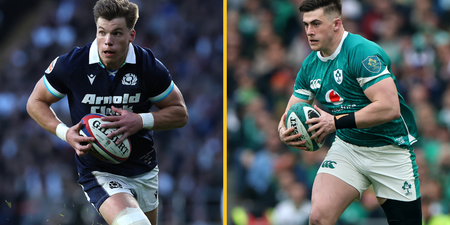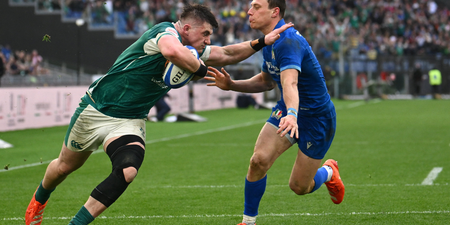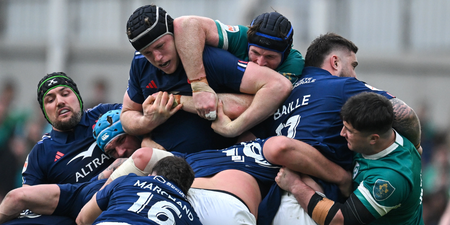“We’re all for keeping the game pure. Keeping it 15 vs. 15”
For the past couple of years, there has been a North and South divide regarding what exactly is ‘a rugby incident’ and what should be a red card. World Rugby has its’ laws, but it is all about how coaches, players, referees, leagues and officials interpret them.
With a host of players, the world over, retiring each year due to concussions and post-concussion symptoms, World Rugby is always assessing whether their laws and protocols are doing enough to protect players. One of the latest drives is trying to get players to lower tackle heights.
World Rugby wants the head and neck to be off-limits, as much as possible in a heavy contact game. Ireland’s Bundee Aki has twice been red-carded for going in for tackles too high, with shoulders or chests colliding with the head of his opponent.
A recent red card decision that went in Ireland’s favour, but not for poor James Ryan, was Charlie Ewels getting sent off after 90 seconds for a high hit on the lock. Ewels was apologetic for the collision, which saw Ryan stood down from training and matches for over a month.
On Saturday, New Zealand tighthead Angus Ta’avao was sent off for going in too high when trying to stop Garry Ringrose in his tracks. There was no intent from Ta’avao but he had been caught out by Ringrose cutting inside and did not get low quick enough, before opting to step in on the Ireland centre.
Both men clashed heads and needed on-field medical treatment. Both would go off for Head Injury Assessments, with Ringrose having a confirmed concussion. Ta’avao was red-carded by referee Jaco Peyper on his way off.
Despite Peyper being a South African ref, and some of the big calls going the way of the All Blacks, it has been claimed that southern hemisphere sides, like Australia and New Zealand, may be getting harshly treated in these games, because that is what World Rugby is in favour of.
Yep, you read that right.
Garry Ringrose of Ireland receives medical attention after colliding with Angus Ta’avao of New Zealand. (Photo by Hagen Hopkins/Getty Images)North vs. South divide
On Rugby Direct, from Newstalk ZB, Kiwi rugby reporter Liam Napier was asked where professional rugby was going to, after two weekends filled with yellow and red card decisions.
“There’s a couple of points I’d like to make there,” said Napier, “and it is the same argument I’d be making if that was an Irish player that caused that collision.
“You look at how a lot of the rules are progressed, interpreted, and what is signed off and not – when you look at the 20-minute red card.
“It is a real reflection that World Rugby is based in Dublin, and it favours the northern hemisphere. I don’t think that is disputed at all.
“Eddie Jones and England were the one northern hemisphere nation that supported that 20-minute [red card] law. If you had that at the game, at the weekend, I think that would have been a fairer reflection of the incident, if you want to go down this path [seeking to lower tackle height]. I don’t agree with it, and I don’t see them change it either. Certainly, it is here to stay.”
Napier contends that the focus on improving tackle technique, lowering tackle height and being harsh on head collisions, where the tackler is concerned, has not been proved to lower player concussions.
All we would say to that is, we have not seen any definitive study on the matter, since the law enforcement became tougher, but World Rugby seem to be proactive on trying to cut down on concussions rather than, as they have been in the past, reactive.
There were three more yellow cards in Tuesday’s game between Ireland and the Maori All Blacks, for bringing down an maul, a deliberate knock-on and a try-scoring opportunity being denied.
Sky Sport NZ commentators agreed with Jordan Larmour getting sin-binned for his tackle on Conor Garden-Bachop, but debated the two shown to Ollie Norris and Shaun Stevenson.
The Kiwis appear to want as much 15 vs. 15 rugby possible. To keep it “pure”.
Perhaps the message will get through to their players, brought up on free-rein Super Rugby, about not infringing so many laws while they are out there.
“Keith Earls ain’t finished yet.”
Darren Cave and Greg O’Shea talk about their past experiences training and playing with Keith Earls and think that the people who don’t rate him as a great player don’t know what they’re talking about.















































